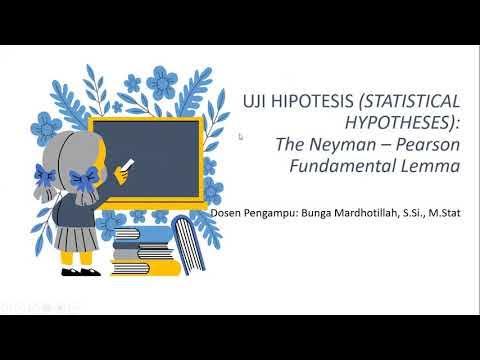Hypothesis Test vs. Confidence Interval | Statistics Tutorial #15 | MarinStatsLectures
Summary
TLDRThe video explains the relationship between hypothesis tests and confidence intervals using a two-sided hypothesis test with a 5% alpha and a 95% confidence interval. It covers how hypothesis testing assumes a population mean and compares the sample mean to this null value using a test statistic and p-value. The video also explains how confidence intervals provide a range of plausible values for the population mean. Both methods, when two-sided and aligned with the same alpha and confidence level, lead to the same conclusions, offering complementary perspectives on statistical inference.
Takeaways
- 🔬 Hypothesis testing and confidence intervals are related concepts for analyzing one numeric variable, specifically a mean.
- 📉 A two-sided hypothesis test is used with a 5% alpha level, and a two-sided confidence interval with 95% confidence.
- 🤔 In a hypothesis test, the population mean is assumed to be equal to a null value, and a test statistic is calculated to compare the estimate to that null value.
- 📊 The p-value from the test indicates how likely it is to get the observed estimate or something more extreme, given that the null hypothesis is true.
- ⚖️ If the p-value is smaller than alpha (5%), the null hypothesis is rejected. If larger, the null is not rejected.
- 🧮 Confidence intervals are built by taking the estimate and adding or subtracting a margin of error, usually around two standard errors.
- 🔗 The sample estimate is the point of reference for confidence intervals, whereas the null value is the reference for hypothesis tests.
- ✅ Confidence intervals and hypothesis tests will always agree in conclusion, assuming both are two-sided with the same confidence level and alpha value.
- 📈 Confidence intervals provide a range of plausible values for the population mean, while p-values give the strength of evidence against the null hypothesis.
- 🧠 Both hypothesis tests and confidence intervals are useful, but reporting both offers a comprehensive view of the data.
Q & A
What is the primary purpose of hypothesis testing?
-The primary purpose of hypothesis testing is to assess whether the population mean is equal to a hypothesized value (null value) by calculating a test statistic and comparing the resulting p-value to a significance level (alpha) to decide if the null hypothesis should be rejected.
What is the role of the p-value in hypothesis testing?
-The p-value represents the probability of observing a sample estimate as extreme as the one obtained (or more extreme) if the null hypothesis is true. It helps determine whether to reject the null hypothesis by comparing it to the chosen alpha level.
What does a two-sided hypothesis test involve?
-A two-sided hypothesis test examines deviations in both directions from the hypothesized value, checking whether the sample mean is significantly higher or lower than the null hypothesis value.
How is a confidence interval constructed?
-A confidence interval is constructed by taking the sample estimate (e.g., mean) and adding and subtracting a margin of error, which is typically around two standard errors, to create a range of plausible values for the population mean.
How can confidence intervals be used in hypothesis testing?
-A confidence interval can be used to test a hypothesis by checking if the null hypothesis value falls within the interval. If the null value is within the interval, the p-value will be larger than the alpha; if it is outside, the p-value will be smaller.
What is the relationship between a 95% confidence interval and a hypothesis test with an alpha of 5%?
-Both methods will lead to the same conclusion about whether to reject or fail to reject the null hypothesis, provided the hypothesis test is two-sided and the confidence interval is 95%.
Why is it recommended to report both the p-value and the confidence interval?
-Reporting both the p-value and the confidence interval provides a fuller picture: the p-value indicates the strength of the evidence against the null hypothesis, while the confidence interval gives a range of plausible values for the population mean.
What is the test statistic, and how is it used in hypothesis testing?
-The test statistic is a standardized value that measures how far the sample estimate is from the hypothesized population mean. It is used to calculate the p-value, which informs whether the null hypothesis should be rejected.
What does it mean if the p-value is larger than the alpha level in hypothesis testing?
-If the p-value is larger than the alpha level, it means there is not enough evidence to reject the null hypothesis, so we 'fail to reject' the null.
How do hypothesis tests and confidence intervals differ in terms of their reference points?
-In hypothesis testing, the null hypothesis value is the reference point, and we test how far the sample estimate is from it. In confidence intervals, the sample estimate is the reference point, and we assess the range of plausible values for the population mean.
Outlines

Cette section est réservée aux utilisateurs payants. Améliorez votre compte pour accéder à cette section.
Améliorer maintenantMindmap

Cette section est réservée aux utilisateurs payants. Améliorez votre compte pour accéder à cette section.
Améliorer maintenantKeywords

Cette section est réservée aux utilisateurs payants. Améliorez votre compte pour accéder à cette section.
Améliorer maintenantHighlights

Cette section est réservée aux utilisateurs payants. Améliorez votre compte pour accéder à cette section.
Améliorer maintenantTranscripts

Cette section est réservée aux utilisateurs payants. Améliorez votre compte pour accéder à cette section.
Améliorer maintenantVoir Plus de Vidéos Connexes

How to calculate One Tail and Two Tail Tests For Hypothesis Testing.

Uji Hipotesis: Lemma Neyman - Pearson (Kuasa Uji)

Confidence Interval for Mean with Example | Statistics Tutorial #10 | MarinStatsLectures

Hypothesis Testing: One Sided vs Two Sided Alternative | Statistics Tutorial #14 |MarinStatsLectures

Hypothesis Testing: Calculations and Interpretations| Statistics Tutorial #13 | MarinStatsLectures

Interpreting Confidence Intervals EXPLAINED in 3 Minutes with Examples
5.0 / 5 (0 votes)
